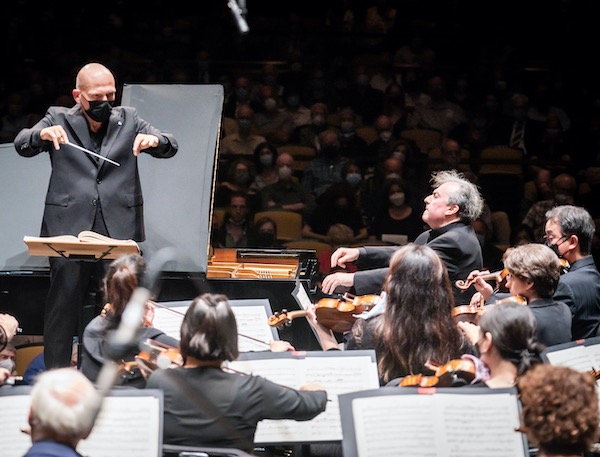A period of adjustment, as Philharmonic acclimates to Rose Theater

The 2021-22 Season of the New York Philharmonic promises to be a long experiment—not so much with musical content but everything to do with concert experiences. Playing in a number of venues, while David Geffen Concert Hall is being renovated, each Philharmonic event is going to explore just how well the orchestra, its venues, and its audience can work together.
Playing in Rose Theater at Jazz at Lincoln Center Thursday night, the Philharmonic and conductor Jaap van Zweden showed that this process is, understandably, right at the beginning and in its exploratory stage. The program of music by contemporary composer Hannah Kendall with Beethoven and Haydn—Yefim Bronfman as soloist in Beethoven’s Piano Concerto No. 3—was solid and satisfying, but the entire concert experience had its perhaps inevitable frustrations.
The relationship between the orchestra and the venue felt tenuous and uncertain, the two feeling each other out like on a first date. Rose Theater is a good place to experience music, with clean sound and sight-lines—just the right size to handle a big group while supporting a sense of immediate presence.
But Thursday night, as an entity the Philharmonic didn’t sound sure about how to work within the space. The flatness of David Geffen Hall was gone, though replaced by a tight, brittle sound and blunt lack of nuance and color, even with the small chamber orchestra configuration for Kendall’s opening piece, Kanashibari.
Written in 2013 and performed in New York City for the first time Thursday, the title is the Japanese word for sleep paralysis. Kendall took that idea and wrote out a piece representing the experience, with a mysterious opening stasis interrupted by what might be external stimuli or inner hallucinations—the stuff our dreams are made of. The narrative arc of the piece may not have resonated with every listener, but the subject was beside the point to the sheer sound. This is music that worked on its own, without having to rely on a program note. Kendall structured the piece with layers that moved, simultaneously, to different pulses and even in different directions, and there was an internal chatter between instrumental groups that expressed a creative nervous energy. One imagines the orchestration to be more colorful than the Philharmonic was able to produce just yet in Rose Theater.
With the full orchestra for the Beethoven concerto and Haydn’s Symphony No. 92, “Oxford,” the sound gained in warmth and, unexpectedly, mellowed a good deal. In these pieces, the drawback was a prevailing stolidity of interpretation. The orchestra played with energy, and string articulation in particular was crisp as starched linen, but aside from careful control of dynamics, not a whole lot else went on.
Maybe control was the issue—too much of it. Tempos felt right but there was no rhythmic variation or subtlety. Van Zweden put just enough emphasis on the downbeat of each measure so that it consistently felt like too much, making things heavy when the music called for spring or bounce— and especially forward flow in the Beethoven—and the excellent syncopations of both composers felt unremarkable.
In the Beethoven, Bronfman and the orchestra played on parallel tracks. The pianist pushed and pulled at the music, changing moods, following the immediate expression of the notes with the hint of intense concentration and spontaneity that is essential to his artistic approach. His playing was equal to the complex variety in the music. On Thursday the orchestra seemed with the soloist only fitfully; the closing Rondo was most successful, the place where the outgoing fun of the music allowed the orchestra to find a sweet spot with the soloist.
Following the bows, van Zweden gently encouraged Bronfman to play an encore, resulting in an expressive, and seemingly deeply personal Chopin Nocturne in D-flat Major, Op. 27.
The same qualifications applied to a well-mannered but anodyne “Oxford” symphony of Haydn. Everything was in the right place yet it still sounded like a perfectly polished dress rehearsal. The heaviness of the rhythms, again, had something to do with the bluntness, even diluted the Menuet—one couldn’t imagine anyone in this court tapping their foot.
With the acknowledgment that this Philharmonic season’s moveable feast is a work in progress, extra-musical aspects of the concert were also a problem. Rose Theater is inside the Time Warner Center, which has no posted Covid policy either inside the building or on its website. Unmasked patrons squeezed into crowded elevators heading up to the theater, and one could see numerous unmasked audience members in defiance of both the city and Philharmonic health protocols. Granted, this is an ongoing experiment, but evidence from the first night in Rose Theater shows there’s a lot of rethinking to do.
This program repeats 8 p.m. Friday and Saturday. nyphil.org






